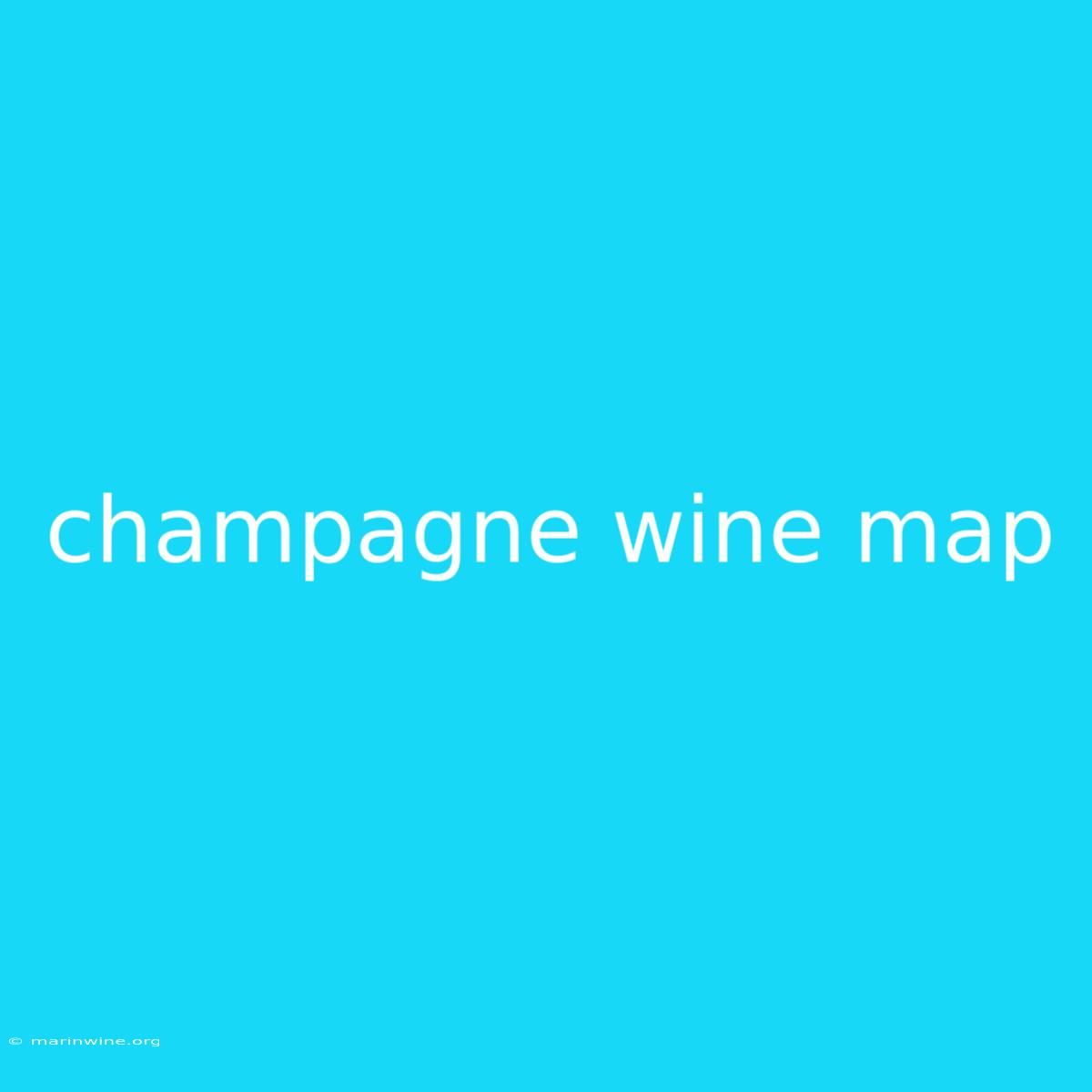Uncorking the Secrets: A Champagne Wine Map Decoded
Have you ever wondered what makes Champagne so special? It's not just the bubbles – it's the unique terroir of the Champagne region in France. This wine map reveals the hidden secrets and fascinating flavors of this iconic sparkling wine.
Why This Matters:
This article delves into the fascinating world of Champagne winemaking, exploring the distinct regions within the appellation and the grapes that create its diverse and captivating flavors. We'll explore the key factors that influence the terroir, from soil composition to climate, providing a comprehensive guide for understanding the complexities of Champagne wine.
Keywords: Champagne, wine map, appellation, terroir, grapes, Chardonnay, Pinot Noir, Pinot Meunier, Grand Cru, Premier Cru, vintage, dosage, cuvée.
Key Takeaways:
| Region | Key Grape | Soil | Climate | Flavor Profile |
|---|---|---|---|---|
| Côte des Blancs | Chardonnay | Chalky | Cool, Continental | Crisp, citrusy, elegant |
| Vallée de la Marne | Pinot Meunier | Clay, Limestone | Cool, Continental | Fruity, floral, smooth |
| Montagne de Reims | Pinot Noir | Clay, Limestone | Cool, Continental | Rich, powerful, structured |
| Côte des Bar | Pinot Noir, Chardonnay | Clay, Limestone | Cool, Continental | Fruity, complex, earthy |
Champagne Wine Map: A Journey Through Terroir
The Champagne region is divided into five distinct areas:
Côte des Blancs: The Chardonnay Heart
This area, primarily focused on the Chardonnay grape, is known for its chalky soils and cool climate, creating crisp, elegant wines with citrus and floral notes. Famous for its Grand Cru vineyards, the Côte des Blancs produces some of the most prestigious Champagnes.
Vallée de la Marne: Pinot Meunier's Domain
The Vallée de la Marne is the heartland for Pinot Meunier, a grape known for its fruity and floral characteristics. Clay and limestone soils contribute to the region's smooth and approachable style. Many Premier Cru vineyards dot this area.
Montagne de Reims: The Pinot Noir Powerhouse
Dominated by Pinot Noir, the Montagne de Reims produces powerful and structured wines with rich flavors of red fruit and spice. Clay and limestone soils and a cool continental climate contribute to this region's unique character. This area is home to some of Champagne's most sought-after Grand Cru vineyards.
Côte des Bar: The Emerging Star
Located further south, the Côte des Bar boasts a blend of Pinot Noir, Chardonnay, and Pinot Meunier. The region's clay and limestone soils combined with a cool climate result in fruity, complex, and earthy Champagnes with a unique character.
The Aube: A Southern Gem
The Aube is the newest Champagne region, known for its rich Pinot Noir and fresh Chardonnay, creating bold and structured wines. The region's clay and limestone soils and cool climate lend unique flavors to its sparkling creations.
Understanding Champagne's Complexity: Key Factors
Grapes: While Chardonnay, Pinot Noir, and Pinot Meunier are the primary grapes, other varieties can be used in small quantities. Each grape contributes specific flavors and qualities to the blend.
Soil: The region's chalky soils, primarily composed of limestone, contribute to the crisp acidity and minerality of Champagne.
Climate: The cool continental climate, with its long, cold winters and warm, sunny summers, plays a significant role in the development of the grapes.
Dosage: After the second fermentation, a dosage (a mixture of wine, sugar, and yeast) is added to regulate the sweetness level. This affects the final flavor profile of the Champagne.
Cuvée: A cuvée refers to a specific blend of grapes used for a particular Champagne. This blend can vary significantly depending on the producer and the desired style.
Vintage: Champagne made from a single year's harvest is designated as "vintage," indicating a higher quality and unique character.
FAQ: Unveiling the Mysteries of Champagne
Q: Is Champagne the same as sparkling wine?
A: No, while Champagne is a sparkling wine, not all sparkling wines are Champagne. True Champagne can only be produced in the Champagne region of France, following strict regulations.
Q: How do I know if I'm drinking a real Champagne?
A: Look for the "Appellation d'Origine Contrôlée (AOC)" label, which guarantees the authenticity of the wine.
Q: What is the difference between Blanc de Blancs, Blanc de Noirs, and Rosé Champagne?
A: Blanc de Blancs is made solely from Chardonnay, Blanc de Noirs from Pinot Noir and/or Pinot Meunier, and Rosé Champagne is produced using red grapes with a short skin contact to impart a pink hue.
Q: What is the best way to serve Champagne?
A: Serve Champagne chilled in a flute or tulip-shaped glass.
Q: Can I keep Champagne for a long time?
A: Yes, Champagne can age for decades, developing complex flavors and aromas.
Q: What are some iconic Champagne houses?
A: Moët & Chandon, Dom Pérignon, Veuve Clicquot, Krug, and Bollinger are some of the most renowned Champagne houses.
Tips for Discovering Your Perfect Champagne:
1. Start with a Classic Brut: This dry style offers a balance of flavors and is a great introduction to Champagne.
2. Explore Different Regions: Discover the unique flavors of the Côte des Blancs, Vallée de la Marne, Montagne de Reims, and Côte des Bar.
3. Consider Vintage Champagne: For special occasions, opt for a vintage Champagne, offering complex flavors and age-worthiness.
4. Seek out Smaller Producers: Discover the craftsmanship and unique character of smaller Champagne houses.
5. Pair Champagne with Food: Explore the wonderful pairings between Champagne and dishes like seafood, white meats, and desserts.
Summary: Unveiling the Soul of Champagne
This wine map has been a guide to understanding the diverse and complex flavors of Champagne. From the chalky soils of the Côte des Blancs to the powerful Pinot Noir of the Montagne de Reims, each region contributes unique flavors to the world of Champagne. By exploring these regions and their nuances, you can deepen your appreciation for this iconic sparkling wine. So, raise a glass to the magic of Champagne and embark on a journey of discovery!

